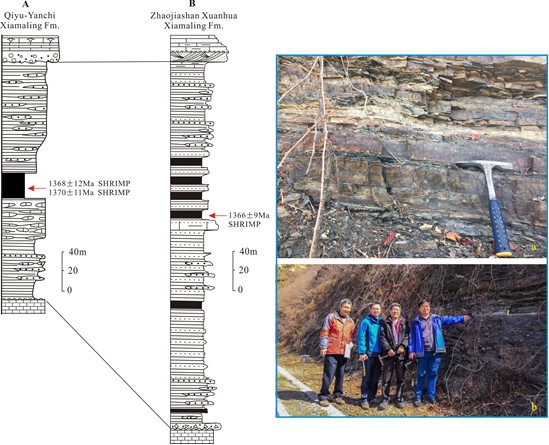Xiamaling Fm
Type Locality and Naming
The Xiamaling Fm was named by L. F. Yih (Ye Liangfu) in 1920. The Stratatype section is located at Xiamaling village, Mentougou district, Beijing Municipality. The parastratatype section is located at Zhaojiashan of Huailai County, Hebei Province.
Synonym: (下马岭组)
Lithology and Thickness
The Xiamaling Formation consists of four members. First (lowest) member is composed of cherty breccia, iron-bearing sandstone, fine-grained sandstone and variegated siltstone, which is subdivided into three parts. Second member in single lithological unit of purple-red, bright green laminar shale with argillaceous rock lenses, and with glauconite sandstone in bottom. Third member consists of gray black and black paper-like carbonaceous shale with tuff and silty shale, and with gray white thin tabular chert rocks. A layer of calcareous quartz sandstone (1.5 m) is developed in the bottom. Fourth (highest) member contains gray black-gray green silty shale, carbonaceous and argillaceous shale and calcareous shale with thin-bedded marl lenses. There are two layers of mudstone lenses in the bottom of this upper member, and at the top is gray clay shale. It is 133-537 m thick.
[Figure: The column of the Xiamaling Formation in Xishan Hill and Huailai section. a-Tuff bedding of the third member of the Xiamaling Fm; b-Sampling locality of the Xiamaling Fm]
Relationships and Distribution
Lower contact
The base is unconformable with the underlying Tieling Fm
Upper contact
The top is disconformably overlain by the Luotuoling Fm
Regional extent
The Xiamaling Formation is distributed in the Yanshan area and the northern part of the Taiheng Mountains. The huge thickness of the formation is developed in Huailai County and Xinglong area, Hebei Province.
GeoJSON
Fossils
The main taxa of stromatolites are Katavia, Linella, Gymnosolen; The assemblage consists of Clavaphyton combiformis, Scopulimorpha F., Gymnosolen conpragosus, Katavia cf. karatavica, Inzeria tiomusi, Linella cf. Auis, L. inconspicua, L. akka, L. sinica, Patomia cf. assica, Jurusania asymmetrica, Insiticinia xiamalingensis, Tsingrakounia vaginata. Abundant microplants are Brochopsophosphaera, Tasmanites, Arctacellularia, Polysphaeroides, Trachyminuscula, stictosphaeridium, Trachysphaeridium, Pseudozonospahereium, Microconcentrica, Taeniatum, Orygmatosphaeridium, Nucellosphaeridium, Gloeocapsomorpha.
Age
Depositional setting
Additional Information
